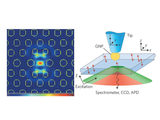“Modified spontaneous emission in nanophotonic structures”
Nature Photonics 9, 427 - 435 (2015).
The URL for the article is http://www.nature.com/nphoton/journal/v9/n7/full/nphoton.2015.103.html
Nearly all of the light that reaches our eyes, whether it comes from the Sun, a light bulb, or the glowing display of a computer or smartphone, is generated by a physical process known as spontaneous emission. The rate at which spontaneous emission occurs — that is, the amount of light given off by a material — was long thought to be an unchangeable property of the material involved. However, we now understand it as arising from a quantum-mechanical interaction between the material and its environment. It is thus possible to modify spontaneous emission by changing the environment of a light-emitting material. This article reviews a range of research in modified spontaneous emission, pointing out common physical principles and clearing up potential misconceptions and pitfalls in interpreting experimental data. It also reviews a few applications that this research may enable, including chemical and biochemical sensors, optical communication and information processing, and conversion of sunlight into electricity.
Nature Photonics 9, 427 - 435 (2015).
The URL for the article is http://www.nature.com/nphoton/journal/v9/n7/full/nphoton.2015.103.html
Nearly all of the light that reaches our eyes, whether it comes from the Sun, a light bulb, or the glowing display of a computer or smartphone, is generated by a physical process known as spontaneous emission. The rate at which spontaneous emission occurs — that is, the amount of light given off by a material — was long thought to be an unchangeable property of the material involved. However, we now understand it as arising from a quantum-mechanical interaction between the material and its environment. It is thus possible to modify spontaneous emission by changing the environment of a light-emitting material. This article reviews a range of research in modified spontaneous emission, pointing out common physical principles and clearing up potential misconceptions and pitfalls in interpreting experimental data. It also reviews a few applications that this research may enable, including chemical and biochemical sensors, optical communication and information processing, and conversion of sunlight into electricity.
Posted: July 1, 2015, 12:09 PM
